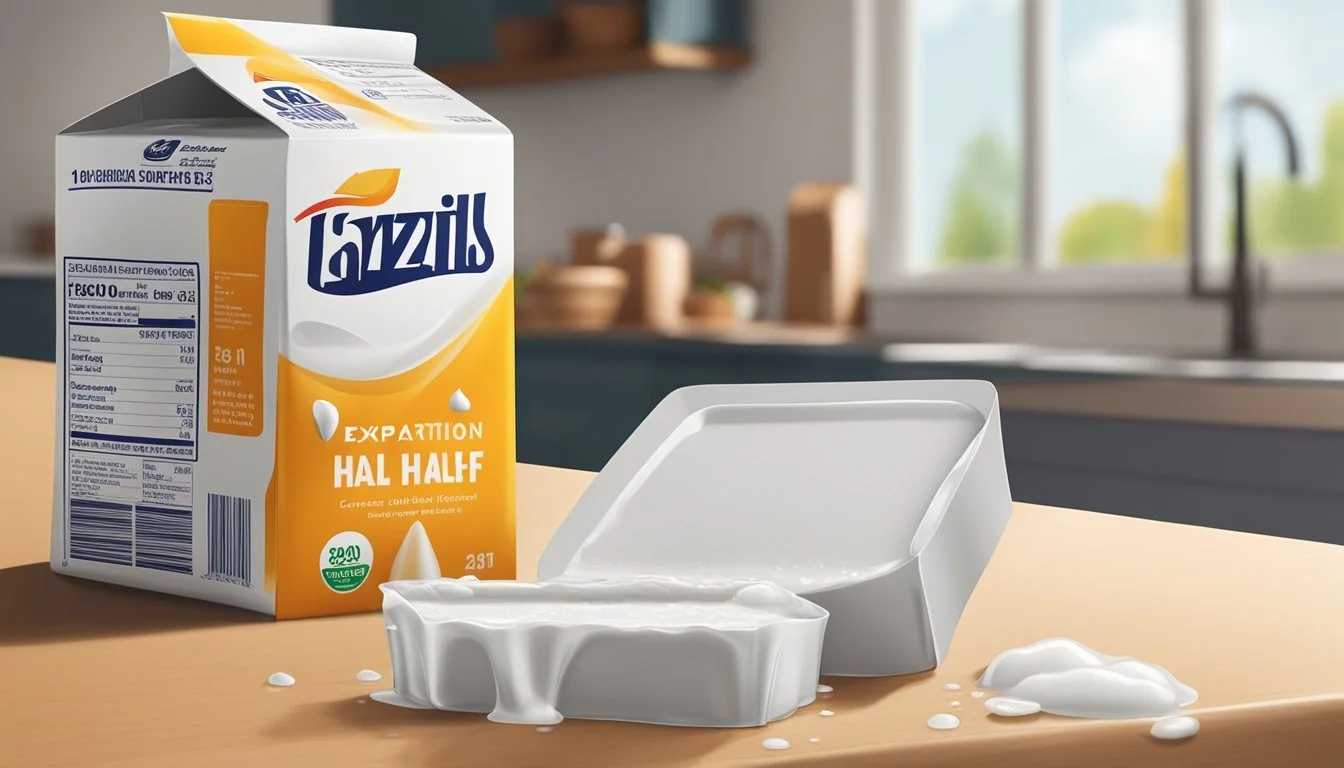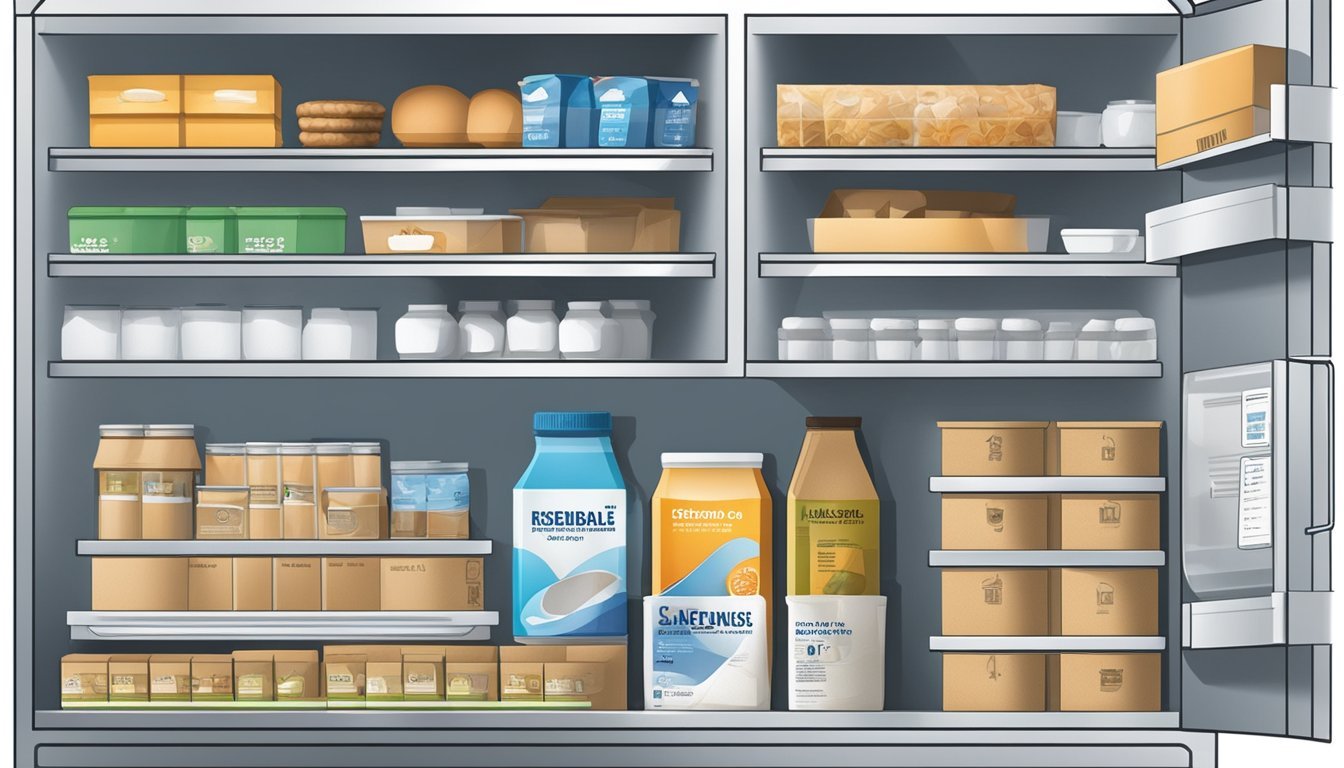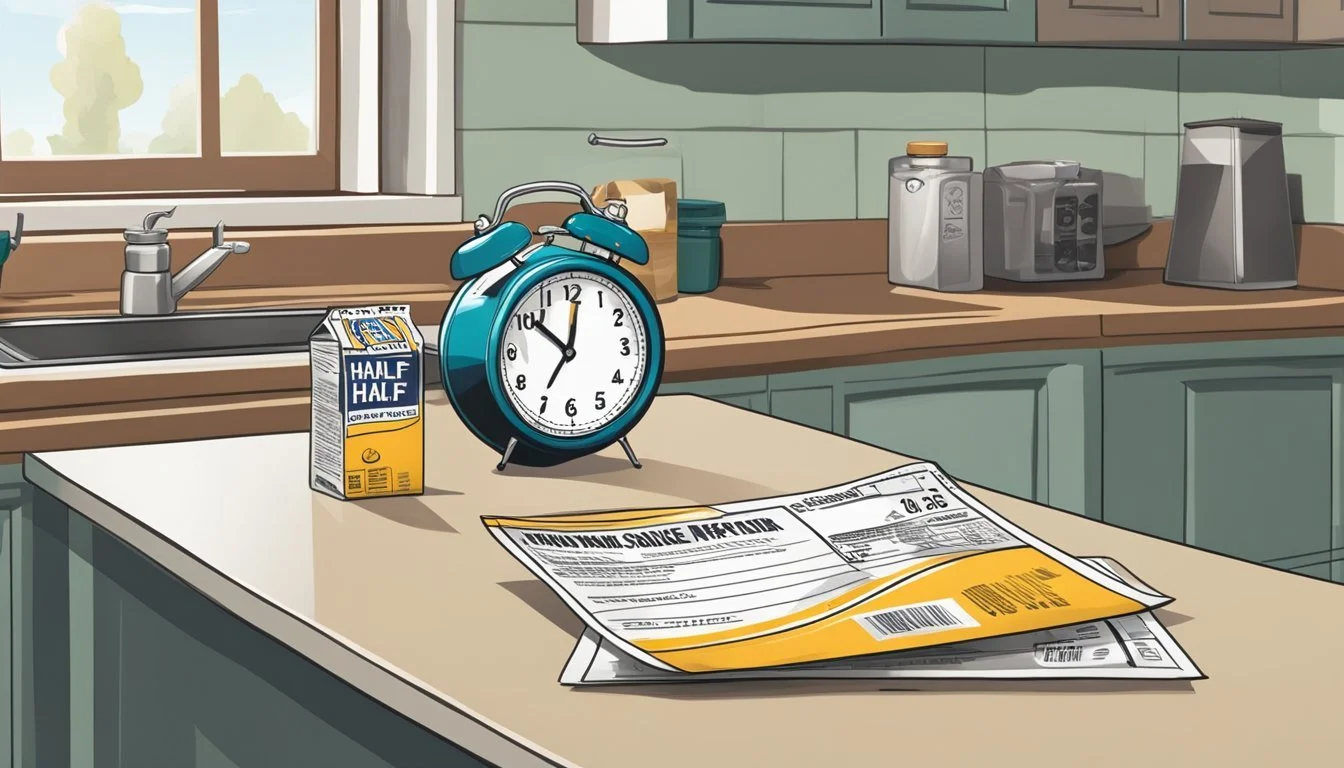How Long Does Half-and-Half Last?
Shelf Life and Storage Tips
Half-and-half, a dairy product consisting of equal parts milk and cream, is a staple in many kitchens for its rich and creamy texture that enhances the flavor of coffee, tea, and various recipes. Its delicate nature, however, raises questions about its shelf life and proper storage methods. The longevity of half-and-half is influenced by several factors, including whether it is opened or unopened, the type of pasteurization used, and how it is stored.
Unopened half-and-half typically lasts about 5-7 days beyond the date printed on the carton if kept in the refrigerator. Once opened, its freshness can be maintained for about 7-10 days when refrigerated promptly after use. The type of pasteurization, whether traditional or ultra-pasteurization, affects its shelf life, with ultra-pasteurized products generally offering a longer sell-by date due to the higher temperatures used during processing to eliminate bacteria.
It's essential to observe storage practices to ensure the quality of half-and-half. Keeping it continuously refrigerated and well-sealed prevents spoilage and maintains its quality for the expected duration. Those looking to extend the life of their half-and-half can opt to freeze it; though this might slightly alter the consistency, the product is usually still acceptable for use in cooked or baked dishes.
Understanding Half-and-Half
Half-and-Half is a versatile dairy product known for its smooth texture and role as a staple in coffee and recipes. This section explores its composition and what exactly it is.
What Is Half-and-Half?
Half-and-Half is a dairy product that combines equal parts of milk and cream to create a light cream with a fat content that ranges between 10.5% to 18%. It is commonly used to enrich coffees or in various cooking and baking recipes due to its rich flavor and texture compared to milk alone.
Components of Half-and-Half
The primary ingredients of Half-and-Half are milk and cream. Here is a breakdown of its components:
Milk: This is the liquid that comes from the mammary glands of dairy cows. Milk has a lower fat content which makes Half-and-Half lighter than cream.
Cream: It is the high-fat part that rises to the top of milk before homogenization. Adding cream to milk increases the fat content, making Half-and-Half creamier than milk.
Storage Guidelines
Proper storage of half-and-half is essential to maintaining its freshness and extending its shelf life. The key factors in storage are temperature control, container choice, and location within your refrigerator or freezer.
Proper Storage Methods
For optimal shelf life, half-and-half should be stored in an airtight container or tightly sealed in its original package. When opened, ensuring the cap or lid is secured after each use minimizes exposure to air, which can spoil the product faster.
Ideal Storage Locations
Half-and-half thrives in consistent, cold temperatures, making the main body of the refrigerator the ideal spot. It's advisable to avoid storing dairy products in the fridge door where temperature fluctuates, potentially compromising its quality.
Impact of Storage Conditions on Quality
Adhering to these storage guidelines is crucial as improper conditions can degrade the half-and-half quickly. Excessively warm temperatures or frequent temperature changes will accelerate spoilage, while correct refrigeration can keep it fresh up to 7-10 days after opening. For extended storage, half-and-half can be kept in the freezer for approximately 3 months, though the texture may change and separation could occur upon thawing.
Shelf Life and Freshness
The shelf life of half and half is paramount in determining its freshness and safety for consumption. It is affected by a variety of factors and differs significantly between unopened and opened cartons.
Unopened Carton Shelf Life
Unopened cartons of half and half generally have a shelf life ranging from seven to ten days past the sell-by date if kept refrigerated. Ultra-pasteurized products have a longer shelf life, often up to six months when refrigerated. The expiration date or best-before date on the packaging serves as a reliable indicator of how long the unopened product will maintain its quality.
After Opening: How Long Will It Last?
Once opened, half and half should be consumed within three to five days to ensure freshness. Opening the carton exposes the content to bacteria and air, which accelerate the process of spoilage. The consumer should always check for signs of spoilage like odor, texture, or taste changes before use, regardless of the days elapsed since opening.
Factors Affecting Shelf Life
Several factors affect the shelf life and quality of half and half:
Temperature: Refrigeration at temperatures below 40°F is critical to slow bacterial growth.
Handling: Proper handling, including minimizing the time half and half is kept out of the fridge, reduces the risk of spoilage.
Packaging: The integrity of the carton or container can influence shelf life; a compromise in packaging can lead to contamination.
Processing: Pasteurization kills bacteria in half and half, extending its shelf life. Ultra-pasteurized half and half undergoes a higher temperature process and thus has an extended shelf life compared to regular pasteurized products.
Proper storage and adherence to recommended usage timelines are key to ensuring the freshness and safety of half and half.
Freezing Half-and-Half
Freezing half-and-half is a viable method to preserve it beyond its typical refrigeration shelf life. This section focuses on effective freezing techniques, the impact of freezing on the quality, and the proper defrosting process.
How to Freeze Effectively
To effectively freeze half-and-half, one should pour it into an airtight, freezer-safe container or bag, leaving some headspace to allow for expansion as it freezes. For convenience, using an ice cube tray is recommended; once the half-and-half is frozen, the cubes can be transferred to a freezer bag, allowing easy portion control when needed.
Freezing vs. Quality
The fat content in half-and-half can affect the consistency upon thawing, as freezing may cause separation or graininess. For this reason, some might notice a change in texture, specifically if the half-and-half is used as a creamer in hot beverages. However, freezing does not affect the product's safety, and it can remain frozen indefinitely, though for best quality, use within three months.
Defrosting Process
To thaw frozen half-and-half, transfer the required amount from the freezer to the refrigerator and let it thaw slowly. If a quick thaw is needed, placing the frozen half-and-half in a sealed bag and immersing it in cold water can expedite the process. One should avoid microwaving, as it can unevenly thaw and further affect consistency. After thawing, stirring or shaking can help restore uniformity to some extent.
Determining Spoilage
When assessing if half-and-half has spoiled, one should pay close attention to changes in appearance, texture, and odor that signify the product is no longer fit for consumption.
Visual and Textural Indicators
A visual inspection of half-and-half can reveal indicators of spoilage. Fresh half-and-half has a uniform, creamy appearance, while spoiled half-and-half may exhibit off colors, often taking on a yellowish hue. The texture is also telling; it should be smooth and fluid. If the liquid becomes clumpy or has a curdled appearance, it's an indication that the product has gone bad and should not be used.
Olfactory Signs
The smell of half-and-half is a reliable indicator of its quality. Fresh half-and-half has a clean, slightly sweet aroma. If it develops an off smell, sour smell, sour odor, or sour aroma, it's a sign the product is spoiled. It's crucial to trust one's sense of smell; if the half-and-half emits a foul or unusual odor, it is best to discard it as it can indicate the presence of harmful bacteria or mold.
Usage of Half-and-Half
Half-and-half is a versatile dairy product used to enrich the flavor and texture of various beverages and recipes. It lends a balance between milk and cream, with applications ranging from morning coffee to sophisticated culinary preparations.
In Coffee and Beverages
In the realm of coffee and beverages, half-and-half adds a creamy texture and rich taste. It is a preferred addition to coffee for many, as it is thicker than milk but less heavy than cream. When incorporating half-and-half into hot liquid, users should pour it in slowly and stir gently to prevent it from curdling.
Coffee: A splash of half-and-half transforms ordinary black coffee into a smooth, satisfying drink.
Tea: It can add a velvety dimension to black or herbal teas.
Other Beverages: Half-and-half is also used in making hot chocolate, milkshakes, and some cocktail recipes.
Culinary Applications
In cooking and baking, half-and-half serves as a foundational ingredient in many recipes due to its ability to contribute flavor and richness without being overly heavy.
Cooking: It's used in sauces, soups, and pasta dishes, offering creaminess without the weight of heavy cream.
Baking: Bakers use it to moisten doughs and batters, providing a tender crumb to cakes and pastries.
Recipes: From creamy salad dressings to rich custards, half-and-half is a key ingredient that chefs utilize for its flavor and texture.
To ensure optimal results when cooking or baking with half-and-half, one should gradually introduce it to the mixture to avoid separation or curdling.
Health and Safety Considerations
When it comes to half-and-half, ensuring safety and maintaining quality are paramount. The focus lies on preventing foodborne illness and avoiding the consumption of spoiled products.
Risks of Consuming Spoiled Half-and-Half
If one consumes half-and-half that has gone bad, it increases the risk of food poisoning. Spoiled half-and-half may contain harmful bacteria like Salmonella, E. coli, or Listeria, which can lead to severe health issues. Spoilage is often indicated by a sour smell, curdling, or a change in color. It is critical to observe these signs to ensure the half-and-half consumed is of the best quality and safe.
Understanding Foodborne Illnesses
Foodborne illnesses, often caused by consuming contaminated foods or beverages, can lead to symptoms such as nausea, vomiting, diarrhea, and abdominal pain. Half-and-half can become contaminated if it is not properly handled, stored, or if it exceeds its expiration date. To promote food safety:
Store: Keep half-and-half refrigerated at 40°F or below.
Observe: Look for any changes in texture, smell, or color.
Check: Always check the expiration date before use.
Employing these practices helps in maintaining the quality of half-and-half, while minimizing the risk of contamination and foodborne illness.
Frequently Asked Questions
This section addresses common inquiries about the storage and longevity of half-and-half, ensuring it remains safe to enjoy and performs well in your recipes.
Can Half-and-Half Be Refrigerated After Opening?
Once opened, half-and-half should be immediately refrigerated to maintain its quality. It typically remains good for 7-10 days in the refrigerator. Storing it in the original carton or a sealed container is crucial to prevent absorption of other odors.
What Are the Signs It’s Still Good?
One can assess the quality of half-and-half by checking its texture and smell. If it pours smoothly without lumps and has a mild, creamy scent, it is likely still good. Any sour smell or lumpy texture indicates it has spoiled.
Is It Safe to Drink After the Expiration Date?
Half-and-half is often safe to consume for up to one week past the expiration date when unopened and refrigerated. However, if it’s opened, one should use it within 5-7 days. Always inspect the texture and smell before using.
Can You Freeze Half-and-Half?
Freezing half-and-half can extend its life up to 3 months, though it may separate upon thawing. For best results, store in a mason jar or plastic bottle to allow for expansion. It's advisable to shake it well after thawing to improve consistency.
Difference Between Half-and-Half and Heavy Cream?
Half-and-half is a mixture of equal parts milk and cream with about 10-18% fat content, while heavy cream has upwards of 36% fat. Because of this, heavy cream will not curdle as easily when heated and is better for whipping. Half-and-half, due to its lower fat content, is more prone to curdling and cannot be whipped into stiff peaks like heavy cream.







